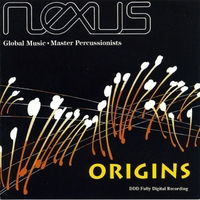 #NEXUSat50 1991 ORIGINS We decided to release our Direct-to-Disc LP Ragtime Concert of 1976 on CD. It would still be a recording of a live performance in every meaning of the word. We also recorded ORIGINS in 1991 and, similar to the ragtime recording, the music on ORIGINS was recorded directly from the studio floor (to two track digital tape), balance and mix were monitored and controlled in real time with no overdubbing or addition of electronic sounds. The music consisted of spontaneous unrehearsed improvisation of the kind that had started our career – hence the title ORIGINS. Editing was limited to the extraction of complete sections from the improvisations. The only musical decision made by each of us in advance of the recording was the selection of musical instruments from our extensive collections. We recorded in late August at Masters Workshop in Rexdale, Ontario. Ray Dillard was the producer and Mark Wright the Engineer. Ray and Bob Becker did the editing and chose the titles for the tracks. Following his new steel pans experience in the Takemitsu concerto, Bob was now comfortable enough to incorporate the pans into our improvisations and he used them on this recording. Thus, one of the tracks is called “A Flash in the Pans”. Bob says, “I used the rack from my Takemitsu setup to suspend the pans. That way I could have them close to any other instruments I chose to use, including small things on a padded table and/or drums on stands. Using steel drums in this way was interesting because usually I don’t know what note is going to come out of a particular spot on the instrument. The pitches on most steel pans are organized in more or less concentric circles, as opposed to the straight lines of marimbas and vibraphones. A physical gesture in a certain direction on a xylophone is predictable in terms of lower or higher pitches. For me, a familiar movement by my hands on the pans produces almost random-sounding results.”
#NEXUSat50 1991 ORIGINS We decided to release our Direct-to-Disc LP Ragtime Concert of 1976 on CD. It would still be a recording of a live performance in every meaning of the word. We also recorded ORIGINS in 1991 and, similar to the ragtime recording, the music on ORIGINS was recorded directly from the studio floor (to two track digital tape), balance and mix were monitored and controlled in real time with no overdubbing or addition of electronic sounds. The music consisted of spontaneous unrehearsed improvisation of the kind that had started our career – hence the title ORIGINS. Editing was limited to the extraction of complete sections from the improvisations. The only musical decision made by each of us in advance of the recording was the selection of musical instruments from our extensive collections. We recorded in late August at Masters Workshop in Rexdale, Ontario. Ray Dillard was the producer and Mark Wright the Engineer. Ray and Bob Becker did the editing and chose the titles for the tracks. Following his new steel pans experience in the Takemitsu concerto, Bob was now comfortable enough to incorporate the pans into our improvisations and he used them on this recording. Thus, one of the tracks is called “A Flash in the Pans”. Bob says, “I used the rack from my Takemitsu setup to suspend the pans. That way I could have them close to any other instruments I chose to use, including small things on a padded table and/or drums on stands. Using steel drums in this way was interesting because usually I don’t know what note is going to come out of a particular spot on the instrument. The pitches on most steel pans are organized in more or less concentric circles, as opposed to the straight lines of marimbas and vibraphones. A physical gesture in a certain direction on a xylophone is predictable in terms of lower or higher pitches. For me, a familiar movement by my hands on the pans produces almost random-sounding results.”
A few of the other track titles are Song of the Nine Iron, The Good Humor Man Meets the Knife Sharpener, and Waltz Happens. You can hear a clip from the cut called “Origins” on the NEXUS website at https://www.nexuspercussion.com/1991/12/nexus-origins-nexus-records-10295/
We loved the graphic for the cover, and we had it printed on our press package covers and on NEXUS T-shirts! Origins is available as a digital download: write to billcahn@aol.com or phone/text (585) 354 5843.
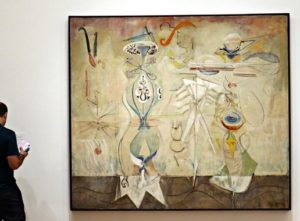
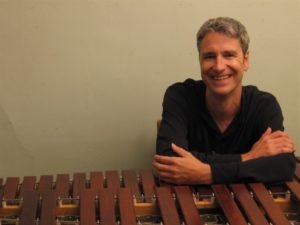
#NEXUSat50 1991 SLOW SWIRL AT THE EDGE OF THE SEA In September we premiered a new piece that composer Mark Duggan had written for us, “Slow Swirl at the Edge of the Sea”. Mark had studied with Russell, Robin and John Wyre and in 1983 was a founding member of Toronto’s Evergreen Club Contemporary Gamelan. The premiere of the new commission took place at the University of Toronto with guest artist Phil Nimmons. (We improvised with Phil on this concert in a piece we dubbed “Nimbus” and would enjoy improvisations with him in future years, too). The title of “Slow Swirl…”comes from a painting by the American artist Mark Rothko, and the various movements of water inspired the piece. Mark has also written a piece in memory of John Wyre called “John’s Gone” and says, “The initial inspiration was not as an homage or memorial…but rather a reflection of my own…responses when it finally sunk in that I would never see him again. John’s delight in the inspiring and unpredictable sound combinations of various bells was limitless, as was his love of a simple melody.” You can listen to both “Slow Swirl…” and “John’s Gone” by scrolling down at https://markduggan.com/music-for-percussion-chamber-ensemble Photos above: Mark Duggan; Mark Rothko’s painting from www.mark-rothko.org
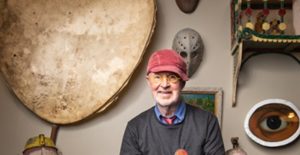 #NEXUSat50 1991 ALL OVER THE MAP Russell tells us that in 1991, our future NEXUS member Garry Kvistad “had the wonderful idea to organize an annual concert in Woodstock, NY called “Woodstock Beat”, a concert of percussion music as a benefit for the Woodstock Guild through his Woodstock Chimes Foundation. For the first 2 years, the concerts were held at the barn of the Guild’s Byrdcliffe Arts Colony and the percussionists were Garry, his brother Rick, Garry’s business partner and former Blackearth colleague Stacey Bowers and me…Bob Becker became a regular participant in 1993 and Bill Cahn often joins us,” along with many interesting guests. You’ll be hearing a lot more about our Woodstock adventures in future posts.
#NEXUSat50 1991 ALL OVER THE MAP Russell tells us that in 1991, our future NEXUS member Garry Kvistad “had the wonderful idea to organize an annual concert in Woodstock, NY called “Woodstock Beat”, a concert of percussion music as a benefit for the Woodstock Guild through his Woodstock Chimes Foundation. For the first 2 years, the concerts were held at the barn of the Guild’s Byrdcliffe Arts Colony and the percussionists were Garry, his brother Rick, Garry’s business partner and former Blackearth colleague Stacey Bowers and me…Bob Becker became a regular participant in 1993 and Bill Cahn often joins us,” along with many interesting guests. You’ll be hearing a lot more about our Woodstock adventures in future posts.
This was another year of being all over the map. In addition to our Japan and France dates, we visited Nebraska, Arizona, Colorado, New York and Michigan, and in Canada, Ottawa and Toronto and 3 western provinces (we helped kick off Winnipeg’s then-new Virtuosi Concert Series) as well as touring Nova Scotia and New Brunswick and participating in the Scotia Festival. 1991 was the year that put the Scotia Festival of Music on the international map – Chris Wilcox pictured above (courtesy of TheCoast.ca) and the festival staff had organized and funded a 5-city Eastern Canadian tour for Pierre Boulez and his Ensemble Intercontemporain (their first visit to Canada), and Boulez stayed on as guest music director after the tour. The Globe and Mail called Scotia Festival of Music 1991 “the greatest music event in Canada’s history.” You can read a wonderful interview done recently with festival founder and director Chris Wilcox, 40 Years and 40 Festivals: https://bit.ly/3jYtJal and see more about the Festival in the Canadian Encyclopedia: https://bit.ly/3nK88Vs
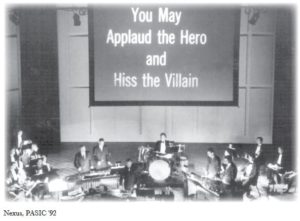 #NEXUSat50 1992 A DOZEN MAESTROS In ‘92 we performed under 12 conductors – performing multiple concerts of Connexus with Andrew Davis (Toronto), Stephen Stein (Anchorage) and D. Mairs (Colorado Springs), the Takemitsu concerto with Raffi Armenian (London and Kitchener Ontario), Carl St. Clair (Pacific Symphony), Uriel Segal (Chautauqua), Lawrence Leighton Smith (Louisville), and Maximiano Valdes (Toronto), and mixed programs with Alan Balter (Memphis) and Peter Bay (St.Paul). #BillCahn conducted us too: We made an addition to our “Rags To Riches” concert (the one using Bill’s vintage theatre-orchestra material), deciding to add our #MackSennett silent film comedy, #TeddyAtTheThrottle (1916) as a grand finale. We introduced #PASIC92 to “Rags to Riches” at the #NewOrleans convention and over the next 8 years we would perform RtoR in many different venues with many different orchestras, with Bill conducting. Alex Pauk conducted us with the Esprit Orchestra (Toronto) for the premiere of a new work by #HarryFreedman called “Touchings” which blended jazz, classical and exotic rhythms from our instrument collection supported by a cleverly orchestrated chamber orchestra accompaniment. While we are talking about new works, we should also mention two #BobBecker pieces composed in 1992, Prisoners of the Image Factory premiered by Arraymusic in Toronto and Noodrem which was commissioned through the Canada Council by Slagwerkgroep Den Haag, premiered the following year in The Hague. Both are recorded on Bob’s CD “There is a Time” (NEXUS label). Photo: Our PASIC’92 concert, compliments of PAS. You can read more about The Evolution of PASIC in an article by Gary Cook at https://pasic.org/wp-content/uploads/2016/03/PASICHistory.pdf
#NEXUSat50 1992 A DOZEN MAESTROS In ‘92 we performed under 12 conductors – performing multiple concerts of Connexus with Andrew Davis (Toronto), Stephen Stein (Anchorage) and D. Mairs (Colorado Springs), the Takemitsu concerto with Raffi Armenian (London and Kitchener Ontario), Carl St. Clair (Pacific Symphony), Uriel Segal (Chautauqua), Lawrence Leighton Smith (Louisville), and Maximiano Valdes (Toronto), and mixed programs with Alan Balter (Memphis) and Peter Bay (St.Paul). #BillCahn conducted us too: We made an addition to our “Rags To Riches” concert (the one using Bill’s vintage theatre-orchestra material), deciding to add our #MackSennett silent film comedy, #TeddyAtTheThrottle (1916) as a grand finale. We introduced #PASIC92 to “Rags to Riches” at the #NewOrleans convention and over the next 8 years we would perform RtoR in many different venues with many different orchestras, with Bill conducting. Alex Pauk conducted us with the Esprit Orchestra (Toronto) for the premiere of a new work by #HarryFreedman called “Touchings” which blended jazz, classical and exotic rhythms from our instrument collection supported by a cleverly orchestrated chamber orchestra accompaniment. While we are talking about new works, we should also mention two #BobBecker pieces composed in 1992, Prisoners of the Image Factory premiered by Arraymusic in Toronto and Noodrem which was commissioned through the Canada Council by Slagwerkgroep Den Haag, premiered the following year in The Hague. Both are recorded on Bob’s CD “There is a Time” (NEXUS label). Photo: Our PASIC’92 concert, compliments of PAS. You can read more about The Evolution of PASIC in an article by Gary Cook at https://pasic.org/wp-content/uploads/2016/03/PASICHistory.pdf
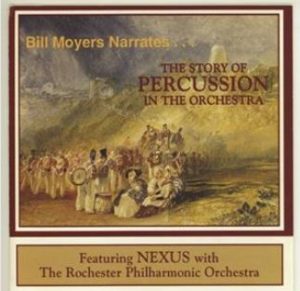 #NEXUSat50 1992 THE STORY OF PERCUSSION In the spring we recorded our family concert, The Story of Percussion In The Orchestra, with the Rochester Philharmonic at the Hochstein School of Music with Bill Cahn conducting. We recorded Bill Moyers’ narration for the recording at the WNET studios in Manhattan later in June. Bill tells us about the cover image he chose for the recording, “Soldiers on the March” (ca. 1828) by J.M.W.Turner. He found the image in a book, “Percussion Instruments and Their History,” by James Blades (Prager, New York, NY, 1970: B&W plate #146). Bill says, “The image is perfectly suited for the text of our ‘Story of Percussion’ which basically conveys – by musical examples – the fact that many of the standard orchestral percussion instruments were originally used primarily for military purposes in the I8th through 19th centuries, and were incorporated into the orchestra by composers who wanted their compositions to have a military character. When NEXUS was in London in August ’92 to perform ‘From me flows what you call Time…’ with the BBC Symphony under Andrew Davis at Royal Albert Hall, I visited the British Museum in London, where I had arranged to see the original Turner watercolor in person to determine if it might be useable as CD cover art. At the museum an attendant led me to a small study room where I was seated while another attendant brought in a box containing the Turner watercolor painting. Amazingly, I was permitted to hold the painting (painted on a heavy paper about 12-inches wide by 8-inches high) for about 5-minutes in my bare hands without a glove or mask. The painting was dazzling: with its bright red soldiers’ uniforms – especially on the drummers who were front and center – and also the coup-de-grace, the characteristic Turner sky. I immediately arranged for the British Museum to grant a license for the image to be used on the NEXUS CD. The recording was released later that year, in December ’92.” NEXUS CD#10306 – “The Story of Percussion in the Orchestra” – is available as a digital download with album notes on a .pdf file, by writing to billcahn@aol.com or phoning/texting (585) 354-5843.
#NEXUSat50 1992 THE STORY OF PERCUSSION In the spring we recorded our family concert, The Story of Percussion In The Orchestra, with the Rochester Philharmonic at the Hochstein School of Music with Bill Cahn conducting. We recorded Bill Moyers’ narration for the recording at the WNET studios in Manhattan later in June. Bill tells us about the cover image he chose for the recording, “Soldiers on the March” (ca. 1828) by J.M.W.Turner. He found the image in a book, “Percussion Instruments and Their History,” by James Blades (Prager, New York, NY, 1970: B&W plate #146). Bill says, “The image is perfectly suited for the text of our ‘Story of Percussion’ which basically conveys – by musical examples – the fact that many of the standard orchestral percussion instruments were originally used primarily for military purposes in the I8th through 19th centuries, and were incorporated into the orchestra by composers who wanted their compositions to have a military character. When NEXUS was in London in August ’92 to perform ‘From me flows what you call Time…’ with the BBC Symphony under Andrew Davis at Royal Albert Hall, I visited the British Museum in London, where I had arranged to see the original Turner watercolor in person to determine if it might be useable as CD cover art. At the museum an attendant led me to a small study room where I was seated while another attendant brought in a box containing the Turner watercolor painting. Amazingly, I was permitted to hold the painting (painted on a heavy paper about 12-inches wide by 8-inches high) for about 5-minutes in my bare hands without a glove or mask. The painting was dazzling: with its bright red soldiers’ uniforms – especially on the drummers who were front and center – and also the coup-de-grace, the characteristic Turner sky. I immediately arranged for the British Museum to grant a license for the image to be used on the NEXUS CD. The recording was released later that year, in December ’92.” NEXUS CD#10306 – “The Story of Percussion in the Orchestra” – is available as a digital download with album notes on a .pdf file, by writing to billcahn@aol.com or phoning/texting (585) 354-5843.
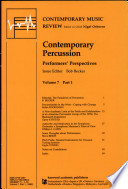 #NEXUSat50 1992 PARADOXES OF PERCUSSION Britain’s Contemporary Music Review invited Bob Becker to edit a 1992 issue about contemporary percussion. He decided to provide a forum for percussion performers and solicited articles from friends and colleagues – among others, Steve Reich, Robin Engelman, Garry Kvistad, Bill Cahn and Gayle Young. All the responses “all raised paradoxical issues, many of which, zen-like, have no reasonable resolution…and they lie at the heart of contemporary percussion performance.” You can read Bob’s entertaining editorial, prefacing the issue, here: https://www.nexuspercussion.com/1990/09/the-paradoxes-of-percussion-2/ You can order a copy of the issue and also read the first part of Robin’s article here: https://bit.ly/376IRPr
#NEXUSat50 1992 PARADOXES OF PERCUSSION Britain’s Contemporary Music Review invited Bob Becker to edit a 1992 issue about contemporary percussion. He decided to provide a forum for percussion performers and solicited articles from friends and colleagues – among others, Steve Reich, Robin Engelman, Garry Kvistad, Bill Cahn and Gayle Young. All the responses “all raised paradoxical issues, many of which, zen-like, have no reasonable resolution…and they lie at the heart of contemporary percussion performance.” You can read Bob’s entertaining editorial, prefacing the issue, here: https://www.nexuspercussion.com/1990/09/the-paradoxes-of-percussion-2/ You can order a copy of the issue and also read the first part of Robin’s article here: https://bit.ly/376IRPr
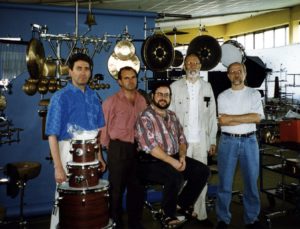 #NEXUSat50 1992 CZECH BORDER CROSSING In June we toured Germany performing in Nuremberg, Munich, Mainz and Stuttgart, with a runout from Munich to Prague, Czechoslovakia. The instruments had been shipped by air, then driven by truck. NEXUS traveled in 2 rental cars and Ray Dillard drove the truck. Bill Cahn joined Ray for the drive from Munich to Prague – the “iron curtain” had only recently opened eastern Europe to free travel from the west. In Germany we had a rented Mercedes cube van but had been advised to avoid such a visibly high-end vehicle for the trip into Czechoslovakia, so Ray and Bill were driving a more nondescript van – a Peugeot. Bill takes up the tale: “Through the Bavarian forest to the Czech border, then two mile-long lanes leading to the customs station. One lane held a long line of trucks but the left lane was wide open. We took it – drove straight up to the customs building – where there was absolutely no sign of life…long empty hallway…a bulletin board filled with truck carnets (customs forms). What to do with our carnet? There seemed to be no one in the building. Should we just leave – and become unofficial visitors to Prague? What if we were caught? Then Ray noticed a tiny rectangular opening about 8 x 4 at waist height. He had to bend way down to look through. On the other side of the wall was a uniformed customs officer, hat slight askew, quietly stamping documents. “Hello!” Much verbal back and forth as none of us understood the other, while Ray, with no stool in sight stoically embraced the absurdity and worked the NEXUS documents through the undersized opening, alternating between speaking (mouth at slot) and listening (ear at slot) – made more bizarre by the lack of any other activity in the building. The officer stamped our pages one-by-one, worked them back to Ray through the slot, and we were on our way.” In Bill’s book “Unpopular Music”, you can read more about Bill and Ray’s Excellent Adventures – including their encounter with the Ghostly Candle of Plzen. The above photo was taken a few days after Prague in Stuttgart at Kolberg Percussion: L-R: Bill, Bernard Kolberg, Ray, John, Russell.
#NEXUSat50 1992 CZECH BORDER CROSSING In June we toured Germany performing in Nuremberg, Munich, Mainz and Stuttgart, with a runout from Munich to Prague, Czechoslovakia. The instruments had been shipped by air, then driven by truck. NEXUS traveled in 2 rental cars and Ray Dillard drove the truck. Bill Cahn joined Ray for the drive from Munich to Prague – the “iron curtain” had only recently opened eastern Europe to free travel from the west. In Germany we had a rented Mercedes cube van but had been advised to avoid such a visibly high-end vehicle for the trip into Czechoslovakia, so Ray and Bill were driving a more nondescript van – a Peugeot. Bill takes up the tale: “Through the Bavarian forest to the Czech border, then two mile-long lanes leading to the customs station. One lane held a long line of trucks but the left lane was wide open. We took it – drove straight up to the customs building – where there was absolutely no sign of life…long empty hallway…a bulletin board filled with truck carnets (customs forms). What to do with our carnet? There seemed to be no one in the building. Should we just leave – and become unofficial visitors to Prague? What if we were caught? Then Ray noticed a tiny rectangular opening about 8 x 4 at waist height. He had to bend way down to look through. On the other side of the wall was a uniformed customs officer, hat slight askew, quietly stamping documents. “Hello!” Much verbal back and forth as none of us understood the other, while Ray, with no stool in sight stoically embraced the absurdity and worked the NEXUS documents through the undersized opening, alternating between speaking (mouth at slot) and listening (ear at slot) – made more bizarre by the lack of any other activity in the building. The officer stamped our pages one-by-one, worked them back to Ray through the slot, and we were on our way.” In Bill’s book “Unpopular Music”, you can read more about Bill and Ray’s Excellent Adventures – including their encounter with the Ghostly Candle of Plzen. The above photo was taken a few days after Prague in Stuttgart at Kolberg Percussion: L-R: Bill, Bernard Kolberg, Ray, John, Russell.
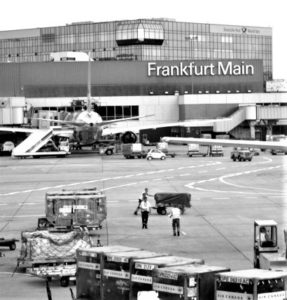 #NEXUSat50 1992 THE PASSING OF JOHN CAGE Maverick Hall, a concert venue in the woods outside Woodstock NY has been a valued part of NEXUS’ history. The hall is notable as the site of the David Tudor’s world premiere of Cage’s famous and infamous 4’33’’ in 1952. Forty years later, in Frankfurt Airport in Germany, Bill Cahn notes, “The last time I saw Cage was on our NEXUS tour in Germany when we crossed paths walking in opposite directions while making airplane connections in Frankfurt Airport.” Bob Becker recalls, “The last time I saw John Cage was at the Frankfurt airport in ‘92. I was walking along one of the concourses when I noticed several people walking toward me. The central figure was wearing a blue denim jacket and stood out, at least to my eyes, like a Hollywood star. I recognized Cage immediately and walked over to say hello. His group clearly was in a hurry to get to their gate, but he stopped for a moment as I reminded him who I was. His final words to me were ‘Nice to see you!’“ Russell Hartenberger recounts, “We were at Frankfurt airport changing planes en route to Toronto. As I was walking to my gate I heard the name ‘John Cage’ called over the airport speaker system telling him to report to his gate. I knew this must be our John Cage, so I changed direction and headed toward the announced gate. By the time I got there, Cage had boarded his plane and I didn’t get to see him. It was just two months later that I heard of Cage’s death in New York City. According to his wishes, Cage was cremated and his ashes were scattered in the Ramapo Mountains, near Stony Point, New York – just down the Hudson River from Maverick Hall where, after four minutes and 33 seconds of silence, music changed.”
#NEXUSat50 1992 THE PASSING OF JOHN CAGE Maverick Hall, a concert venue in the woods outside Woodstock NY has been a valued part of NEXUS’ history. The hall is notable as the site of the David Tudor’s world premiere of Cage’s famous and infamous 4’33’’ in 1952. Forty years later, in Frankfurt Airport in Germany, Bill Cahn notes, “The last time I saw Cage was on our NEXUS tour in Germany when we crossed paths walking in opposite directions while making airplane connections in Frankfurt Airport.” Bob Becker recalls, “The last time I saw John Cage was at the Frankfurt airport in ‘92. I was walking along one of the concourses when I noticed several people walking toward me. The central figure was wearing a blue denim jacket and stood out, at least to my eyes, like a Hollywood star. I recognized Cage immediately and walked over to say hello. His group clearly was in a hurry to get to their gate, but he stopped for a moment as I reminded him who I was. His final words to me were ‘Nice to see you!’“ Russell Hartenberger recounts, “We were at Frankfurt airport changing planes en route to Toronto. As I was walking to my gate I heard the name ‘John Cage’ called over the airport speaker system telling him to report to his gate. I knew this must be our John Cage, so I changed direction and headed toward the announced gate. By the time I got there, Cage had boarded his plane and I didn’t get to see him. It was just two months later that I heard of Cage’s death in New York City. According to his wishes, Cage was cremated and his ashes were scattered in the Ramapo Mountains, near Stony Point, New York – just down the Hudson River from Maverick Hall where, after four minutes and 33 seconds of silence, music changed.”
More: Russell Hartenberger’s wonderful article “Encounters with John Cage” (Percussive Notes, September, 2012).
